Prison camps have generally received less attention, overlooking the fact that they were products of
those horrific battles. Most works relating to this southern Maryland prison camp rarely reach the
depth of research and discussion of both prisoners and guards, which is presented to understand
better what both prisoners and guards experienced. Previously published works generally depict the
guards as cruel and inhuman, displaying little compassion for their charges. Such alleged treatment
by the guard force was not always the case at Point Lookout.
Post-war works reflect biased opinions based solely on the writings of prison survivors. Contemporary
writers on the subject have accepted these memoirs, stories, and reflections as the final word without
questioning their validity. The results presented challenge other researchers who have accepted what
was written in the post-war years as the final word.
Point Lookout Confederate Prisoner of War Camp
As
the
number
of
prisoners
steadily
increased
after
the
battle
of
Gettysburg,
it
became
evident
that
the
number
of
current
Union
prisons
was
not
enough
to
hold
them
all.
As
no
major
prisons
had
been
opened
or
facilities
converted
since
the
Confederate
defeats
at
Fort
Henry
and
Fort
Donaldson
in
1862,Quartermaster
General
of
the
U.S.
Army,
Montgomery
Meigs,
ordered
Brigadier
General
Daniel
H.
Rucker,
Chief
Quartermaster,
to
establish
a
prison
camp
at
Point
Lookout,
Maryland,
capable
of
incarcerating
5,000
prisoners
with
area
enough
to
add
an
additional
5,000
prisoners, or more, when needed.
Point
Lookout
was
established
on
August
1,
1863,
and
became
the
largest
prisoner
of
war
camp
during
the
war.
It
was
located
at
the
extreme
tip
of
St.
Mary’s
County
on
the
long,
low
barren
peninsula
where
the
Potomac
River
joins
the
Chesapeake
Bay.
It
had
been
a
resort
area
with
hotels,
boarding
houses,
cottages,
and
commercial
establishments
prior
to the Civil War.
The
site
was
leased
to
the
federal
government
in
June
1862,
and
quickly
became
a
significant
government
installation.
Even
though
the
site
was
comparatively
isolated,
it
could
be
easily
protected.
At
the
extreme
end
of
the
peninsula,
near
the
lighthouse,
a
1,400-bed
hospital
was
constructed
comprising
sixteen
buildings
arranged
in
a
circle.
Hammond
Hospital
was
supported
by
a
large
wharf
to
receive
supplies
and
the
wounded
soldiers
that
arrived
from
battlefields.
The
hospital
complex
included
a
number
of
storehouses
and
stables;
laundry
and
dining
facilities;
and
additional
quarters
for
officers,
doctors,
surgeons,
and
Union
troops.
The
hospital
became
one
of
the
largest
and
busiest
medical facilities in the Union's service.
A
fifty-acre
site
located
about
a
half
mile
northeast
of
the
hospital
was
selected
for
the
new
prison.
Work
soon
began
by
enclosing
the
area
with
a
twelve-foot-high
fence,
with
a
catwalk
constructed
along
the
top
of
the
fence
for
the
guards.
The
prison
was
divided
into
two
sections;
one
area
of
approximately
thirty-eight
acres
for
the
enlisted
men
and
the
adjoining
site
designated
for
officers
of
approximately
seven
to
eight
acres.
The
inside
of
the
prison
was
a
barren,
flat
stretch
comprised
of
a
mixture
of
part
sand
and
part
clay.
All
of
the
prisoners
were
to
be
sheltered
in
tents
instead
of
barracks.
The
camp
was
prone
to
coastal
flooding
as
the
peninsula
is
approximately
two
feet
above
sea level.
The
prison's
official
name
was
Camp
Hoffman
but
was
seldom
referred
to
by
this
name.
Before
long,
the
prison
became
the
most
populated
and
largest
prison, at one time holding over 20,000 prisoners.
The
first
guard
detail
assigned
to
the
camp
was
the
2
nd
and
12th
New
Hampshire
Infantry
Regiments.
Other
guard
units
assigned
included
the
4
th
Rhode
Island
Volunteer
Infantry,
the
10th,
11
th
and
20
th
U.S.
Veteran
Reserve
Corps
Regiments,
and
the
139
th
Ohio
Infantry.
On
February
25,1864,
the
36th
U.S.
Colored
Infantry
Regiment,
followed
by
the
4th
United
States
Colored
Troops
and
the
5th
Massachusetts
Colored
Cavalry,
would
act
as
prison
guards.
These
regiments
would
soon
be
followed
by
other
U.S.C.T.
units.
United
States
Navy
warships
and
gunboats,
such
as
the
U.S.S.
Minnesota and the ironclad U.S.S. Roanoke, would patrol the waters on both sides of the peninsula.
The
first
commandant
was
Brig.
Gen.
Gilman
Marston.
He
was
replaced
in
December
1863
by
Brig.
Gen.
Edward
W.
Hinks,
in
April
1864
by
Col.
Alonzo
G.
Draper,
and
in
July
by
Brig.
Gen.
James
Barnes.
The
first
prisoners
arrived
in
late
July
and
by
the
end
of
the
year,
the
population
was
more
than
9,000
prisoners. By mid-summer 1864, it was over 15,500 prisoners.
The
prisoner's
tents
were
set
up
in
ten
parallel
streets
referred
to
as
“divisions”
that
ran
east
to
west
within
the
prison.
By
late
1864,
the
divisional
streets
would
increase
to
thirteen
to
accommodate
the
surplus population in the prison.
LIFE & CONDITIONS:
All
prisoners
lived
in
the
overcrowded
tents
and
shacks,
with
no
barracks
to
protect
them
from
heat
and
coastal
storms.
There
were
several
different
kinds
of
tents
that
the
prisoners
used.
Each
row
of
tents
were
labeled
as
a
division
and
would
hold
1,000
or
more
prisoners.
The
majority
of
the
different
types
were:
A-tents
(5
men),
Sibley
tents
(13-14
men),
Hospital
tents
(15-18
men),
Wall
tents
(3-8
men),
Hospital
fly’s
(10-13
men),
Wall-tent
fly’s
(3-8
men),
and
Shelter tents (3 men).
The
eastern
wall
of
the
prison
whose
border
ran
along
shoreline
of
the
bay,
was
provided
with
gates
that
were
opened
to
permit
prisoners
to
bathe,
wash
clothes,
fish
and
gather
oysters.
The
many
water
sources
available
for
drinking
were
usually
contaminated.
The
wells
that
supplied
the
water
for
the
camp
were
usually
dug
too
shallow
and
contaminated
easily.
It
would
not
be
until
the
last
months
of
the
war
that
the
federal
government
arranged
delivery
of
fresh
water by boat to both Hammond Hospital and the prison.
There
was
never
enough
food
or
firewood;
both
were
strictly
rationed.
Rats
were
a
major
source
of
protein
for
some
inmates,
and
catching
them
became
a
favorite
sport
in
the
camp.
Rations
were
supposed
to
consist
of
pork
two
out
of
three
days,
with
beef
on
the
third
day.
The
rations
were
served
twice
a
day,
between
the
hours
of
8:00
and
9:00
a.m.
for
breakfast
and
1:00
to
2:00
p.m.
for
dinner.
The
bread
wagons
would deliver fresh bread generally after the midday ration.
There
were
weekly
inspections
of
the
prisoners
and
prison
camp,
in
which
the
prisoners
would
have
their
shelters
inspected
for
contraband
(illegal
possessions).
Flooding
of
the
prison
compound
was
frequent, often flooding their shelters and making living conditions practically unbearable.
Because of the topography, drainage was poor, and the area was subject to extreme heat in the
summer and cold in the winter. This exacerbated the problems created by inadequate food, sanitation,
clothing, fuel, housing, and medical care. As a result, over 4,000 prisoners died during the twenty-
three months the prison operated.
Besides
chronic
diarrhea,
dysentery
and
typhoid
fever
had
become
epidemic
at
the
camp
while
smallpox,
scurvy,
and
the
itch
had
become quite common.
The
latrines
at
the
camp
were
built
out
over
the
bay
on
the
east
side
of
the
camp
for
use
in
the
daytime.
Large
boxes
and
or
tubs
were used at nighttime.
Daily
activities
in
the
camp
consisted
of
reveille
between
dawn
and
sunrise
and
followed
by
roll
call.
After
breakfast,
the
prisoners
passed
time
by
busying
themselves
with
a
wide
variety
of
occupations and pastimes.
There
were
still
22,000
prisoners
being
held
by
the
end
of
the
war
in
April
1865.They
were
eventually
released
in
a
combination
of
alphabetical
order.
By
June
30th,
all
prisoners
held
at
Point
Lookout
had
been released with the exception of those that were still bed ridden in the hospitals.
It
is
estimated
that
a
total
of
52,264
prisoners,
both
military
and
civilian,
were
held
prisoner
there.
Although
it
was
designed
for
10,000
prisoners,
during
most
of
its
existence
it
held
12,600
to
20,000
inmates. Only 50 escapes were successful at the camp.
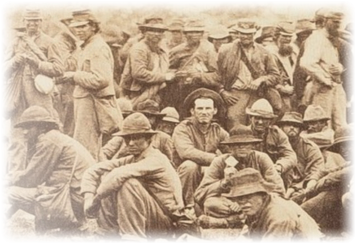
More Details About
Point Lookout, Maryland: The Largest Civil War Prison
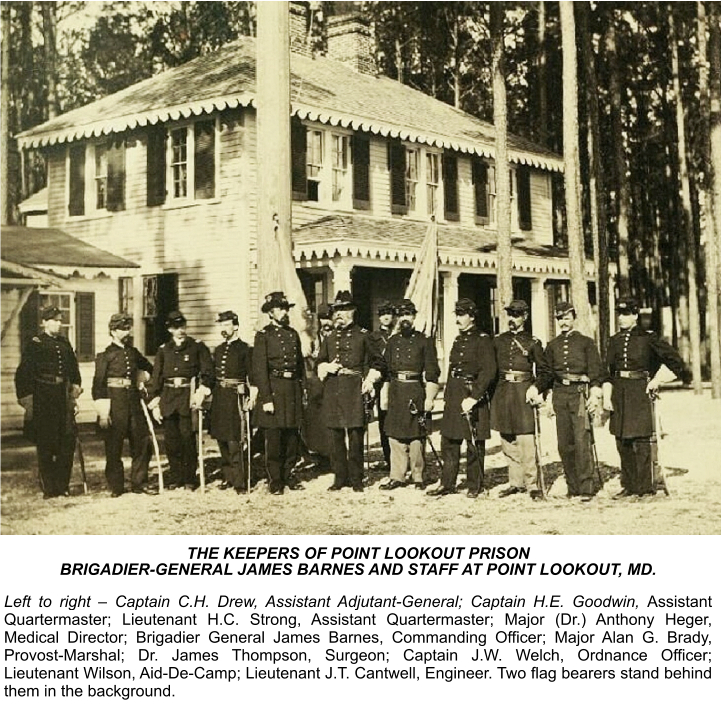
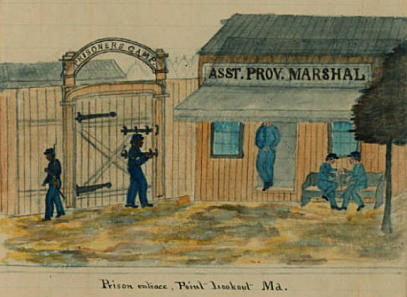
Prisoner and artist John Omenhausser of Co. A, 59th Virginia
Infantry documented his experiences while at Point Lookout Prison.
He drew 65 watercolors and put them in a sketch book. Several
libraries have this sketchbook including the New York Historical
Society: You can view the sketchbook here:
https://digitalcollections.nyhistory.org/islandora/object/islandora%3A31569#page/17/mode/2up

Prisoner and artist John Omenhausser draws a scene on the
beach where prisoners gather crabs and one prisoner shows
another who has never seen a crab to smell his bug.
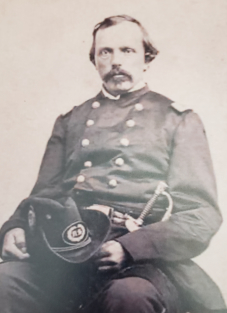
Dr.
Anthony
Heger
served
as
Medical
Director
of
the
hospital
at
Point
Lookout,
Maryland.
- Crickenberger Collection
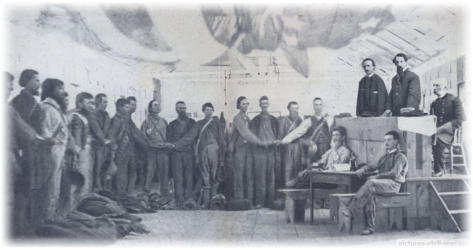
A
group
of
prisoners
stand
in
a
building,
with
the
U.S.
Flag
draped
across
the
ceiling,
each
with
his
hand
on
a
Bible.
A
Union
officer
stands
at
a
dais
administering the oath of allegiance to the Union
.
Copyright © 2025 Robert E Crickenberger
Point Lookout, Maryland:
The Largest Civil War Prison
By Robert E. Crickenberger
A Groundbreaking Book That Rewrites the Legacy
of the Union’s Most Infamous POW Camp
July 1863 – August 1865












